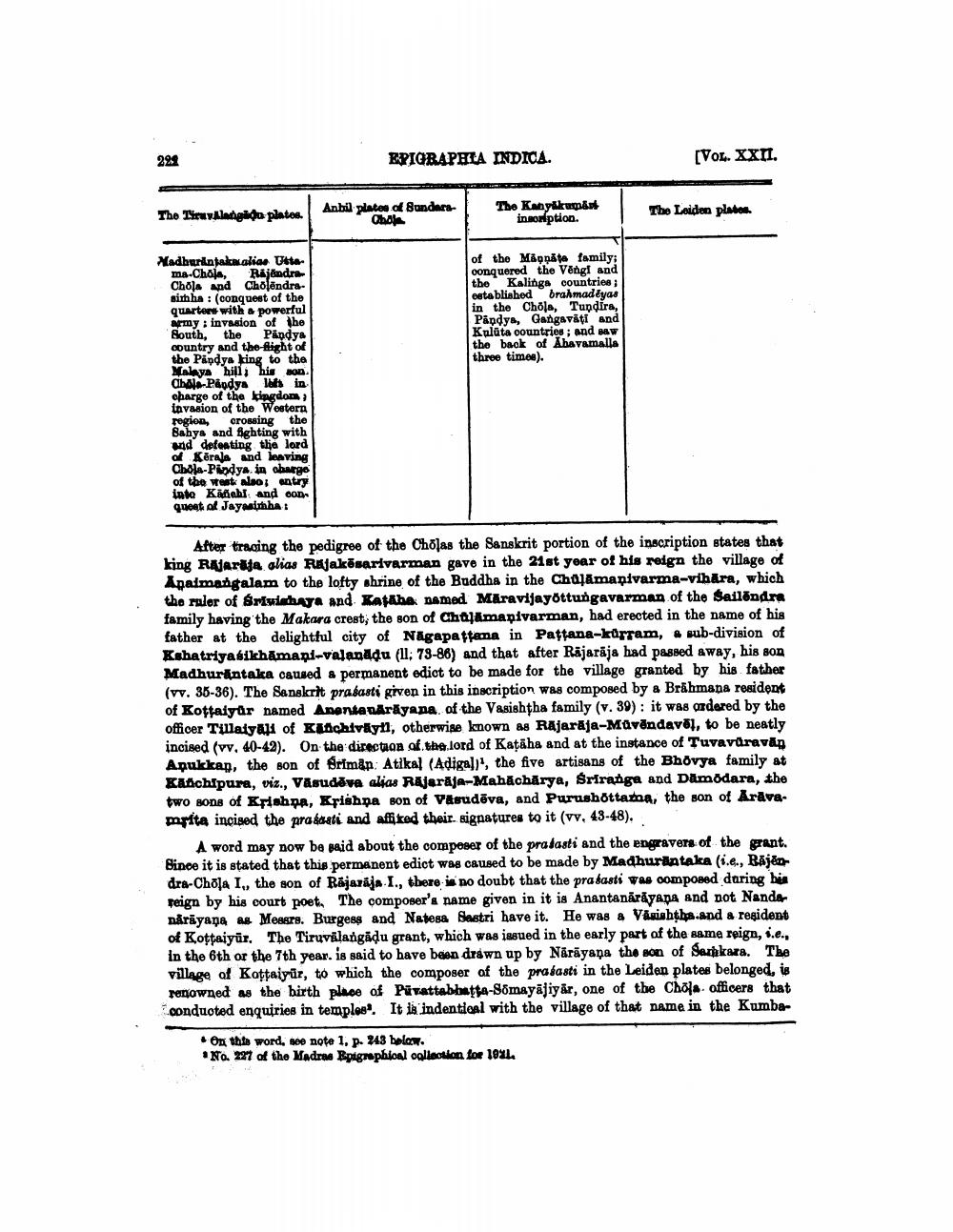________________
229
The TravAlangidu plates.
Madhurantakaalias Utta
ma-Chōja, Rajendra Chola and Cholendrasimha: (conquest of the quarters with a powerful army: invasion of the South, the Pandya country and the-flight of the Pandya king to the Malaya hill; his son. Chala-Pandya lefs in charge of the kingdom; invasion of the Western region, crossing the Bahya and fighting with and defeating the lord of Kerala and leaving Chola-Pindya in obarge of the west also; entry into Kañahl and con quest of Jayasimha :
EPIGRAPHIA INDICA.
Anbil plates of SundaraOhôja
The Kanyakumari insoription.
of the Mappate family; conquered the Vengi and the Kalinga countries; established brahmadeyas in the Chola, Tundira, Pandya, Gangavati and Kuluta countries; and saw the back of Ahavamalla three times).
[VOL. XXII.
The Leiden plates.
After tracing the pedigree of the Cholas the Sanskrit portion of the inscription states that king Rajaraja alias Rajakesarivarman gave in the 21st year of his reign the village of Apaimangalam to the lofty shrine of the Buddha in the Chalamanivarma-vihara, which the ruler of Sriwishaya and Kataha named Märavijayöttungavarman of the Sailendra family having the Makara crest, the son of Chalamanivarman, had erected in the name of his father at the delightful city of Nagapattana in Pattana-kürram, a sub-division of Kshatriyasikhamani-valanadu (11; 73-86) and that after Rajaraja had passed away, his son Madhurantaka caused a permanent edict to be made for the village granted by his father (vv. 35-36). The Sanskrit prasasti given in this inscription was composed by a Brahmana resident of Kottaiyar named Anentanarayana of the Vasishtha family (v. 39): it was ordered by the officer Tillaiyali of Käñchiväyll, otherwise known as Rajaraja-Müvändavel, to be neatly incised (vv. 40-42). On the direction of the lord of Kaṭaha and at the instance of Tuvaväravāņ Apukkap, the son of Sriman: Atikal (Adigal), the five artisans of the Bhovya family at Kanchipura, viz., Vasudeva alias Rajaraja-Mahacharya, Sriranga and Damodara, the two sons of Krishna, Krishna son of Vasudeva, and Purushottama, the son of Aravamrita incised the prasasti and affixed their signatures to it (vv. 43-48).
On this word, see note 1, p. 243 below.
*No. 227 of the Madras Epigraphical collection for 1921.
A word may now be said about the composer of the prasasti and the engravers of the grant. Since it is stated that this permanent edict was caused to be made by Madhurantaka (i.e., Rājān dra-Chola I,, the son of Rajaraja I., there is no doubt that the prasasti was composed during his reign by his court poet. The composer's name given in it is Anantanarayana and not Nandanarayana as Messrs. Burgess and Natesa Sastri have it. He was a Vasishtha.and a resident of Kottaiyür. The Tiruvalangaḍu grant, which was issued in the early part of the same reign, i.e., in the 6th or the 7th year. is said to have been drawn up by Narayana the son of Sarkara. The village of Kottaiyur, to which the composer of the prasasti in the Leiden plates belonged, is renowned as the birth place of Pavattabbatta-Somayajiyar, one of the Chola officers that conducted enquiries in temples. It is indentical with the village of that name in the Kumba




